+7 (812) 929-8283
Маршрутизаторы Cisco с интегрированными услугами серии 3700
Cisco 3700 Series Multiservice Access Routers
DATA SHEET
Access Platform Optimized for the Modular Integration of Branch Office Applications and Services
INTRODUCTION
The Cisco® 3700 Series Multiservice Access Routers are a family of modular routers that enable flexible and scalable deployment of new e-business applications for the Full Service Branch (FSB) office. The Cisco 3700 Series routers optimize the branch office with high performance routing, integrated low density switching, Security, Voice, IP Telephony, voice mail, Video and Content Networking in a single integrated solution. This unique integrated design enables enterprise customers to incrementally adapt to evolving business needs by enabling important services delivered by Cisco IOS®, such as Quality of Service (QoS), IP Multicast, VPN, Firewall, and Intrusion Prevention, with the performance required for tomorrows' business challenges. The Cisco 3700 Multiservice Access Routers are based on the same modular concepts as the Cisco 3600 Series but enable dramatically higher levels of performance and service integration for the branch office.
The Cisco 3725 and Cisco 3745 provide on-board LAN/WAN connectivity, new high-density service modules (HDSM), and support for multiple Advanced Integration Modules (AIMs) to deliver the highest levels of service density for the enterprise branch office today. Improving on the success of the Cisco 3600 Series' modular architecture, these highly integrated platforms deliver a compelling value proposition by integrating components previously purchased separately, such as two fixed 10/100 LAN ports and additional memory. With the options of two or four network module slots-which can be adjusted to accept the HDSM modules-three WAN Interface Card (WIC) slots, and two on-board AIM slots, the Cisco 3700 offers many flexible options to enable high densities of services. Providing support for the majority of LAN and WAN interfaces available today on the Cisco 3600 Series platforms reinforces Cisco investment protection promise and maximizes the flexibility of these platforms for the future.
CISCO 3700 MULTISERVICE ACCESS ROUTER OVERVIEW
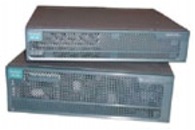
The modular Cisco 3700 Series Multiservice Access Routers leverage network modules (NMs),WAN Interface Cards (WICs), and Advanced Integration Modules (AIMs) from the Cisco 1700, 2600, and 3600 Series Routers for WAN Access, Voice Gateway, Security, Content, Circuit Emulation, and Dial applications. In addition, the Cisco 3725 and Cisco 3745 introduce a new, doublewide form factor, that provides support for the high density services modules (HDSM's). The Cisco 3745 with four network module slots can accept up to two HDSM's by removing the center guides between each pair of adjacent NM slots. The Cisco 3725, with two network module slots can accept a single HDSM in the upper network module slot by removing the blank panel and still have an available network module slot. By utilizing the new HDSM capability the Cisco 3700 Series routers are able to integrate higher port density and new, high performance services.
Figure 2

3745 Multiservice Access Router (shown with optional interfaces)
Figure 3
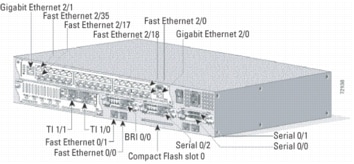
3725 Multiservice Access Router (shown with optional interfaces
Also new in the Cisco 3700 Series is the ability to support integrated In-Line Power on optional 10/100 switching modules for IP Telephony and/or Aironet Wireless LAN applications. By integrating the connectivity slots and ports on the base chassis, the Cisco 3700 Series enables the NM slots to integrate additional services in a small footprint. Both Cisco 3700 platforms offer increased Flash and DRAM default memory to accelerate and simplify future service and feature additions. In addition, the Cisco 3745 router offers additional availability features that may be required in high density, multiple services configurations.
Key features for the Cisco 3725 and 3745:
Table 1. Cisco 3700 Series Key Features and Benefits
|
Feature |
Benefit |
|
|
Investment Protection |
||
|
Modular platform which shares interfaces with Cisco 1700, 2600, 3600 |
|
|
|
LAN/WAN Connectivity integrated into chassis |
|
|
|
VPN and Security configurations |
|
|
|
Flexible voice gateway and IP Telephony configurations |
|
|
|
Cisco IOS Software |
|
|
|
Scalability |
||
|
Increased AIM (2) and WIC density (3) |
|
|
|
Increased default memory of 32MB Compact Flash and 256 MB DRAM |
|
|
|
New High Density Service Modules (HDSM) |
|
|
|
Availability |
||
|
Support for Optional Redundant Power |
|
|
|
Survivable Remote Site Telephony |
|
|
|
Online Insertion and Removal-capable (3745 only) |
|
|
|
Field-replaceable motherboard, I/O board, power supplies and fan tray (3745 only) |
|
|
ADVANCED INTEGRATION MODULE OPTIONS
The Cisco 3700 Series are equipped with two internal slots to support one or two field-installable AIMs. AIMs use function-specific hardware to off-load the main router CPU and accelerate processor- or resource-intensive services, yielding dramatically higher throughput and higher performance than a software-only implementation. The AIM slot has access to virtually all of the router's resources, including the main system bus. The TDM bus and the serial communications controllers make this a very flexible and powerful feature. Since the AIM is internally mounted, external slots remain available for integration of other modular components such as CSU/DSUs, WAN interfaces, or other devices such as modems, or packetized voice/fax processors.
The Data Compression AIM provides a cost-effective option for reducing recurring WAN costs and maximizes the benefit of the advanced bandwidth management features of the Cisco IOS software. With compression ratios of up to 4:1, each integrated Data Compression AIM supports 4 T1/E1s of compressed data throughput with one AIM and up to 8 T1/E1 with two AIMs. The Data Compression AIM supports industry standard LZS and Microsoft Point-to-Point Compression (MPPC) algorithms and ensures compatibility with all Cisco products supporting hardware- or software-based compression.
Three combination Voice + ATM AIM modules are available on the Cisco 3700 Series. The AIM-ATM provides asynchronous transfer mode (ATM) services to the WAN. The AIM-VOICE-30 provides digital signal processor (DSP) services, which can support up to 30 medium-complexity voice channels. The AIM-ATM-VOICE-30 combines the features from the AIM-ATM and AIM-VOICE-30 modules onto a single AIM module. These AIM modules supplement the broad portfolio of Cisco voice solutions and allow enterprises and service providers the flexibility of implementing ATM and voice solutions on the routers. These three Voice and ATM AIM modules provide a cost-effective option for reducing recurring cost and maximizing the benefits of the advanced bandwidth management features of the Cisco IOS software.
The AIM-ATM offers ATM adaptation layer 2 (AAL2), and ATM adaptation layer 5 (AAL5) support for low-density T1/E1 data and voice connections over ATM networks. It supports up to 4 T1/E1 of IMA with a single AIM-ATM, and 8 T1/E1 of IMA with two AIM-ATM's (maximum 4 T1/E1 IMA bundle). This AIM module allows service providers and enterprise customers to take advantage of the reliability and quality of service (QoS) available with ATM connectivity. The AIM-VOICE-30 contains DSPs that can support up to 30 medium-complexity voice channels when used with the Voice/WAN (VWIC-MFT) interface card. When the AIM-VOICE-30 can be used in a Cisco 3700, for voice over IP (VoIP) or voice over Frame Relay (VoFR) connectivity while freeing up the network module slot for other applications. The AIM-ATM-VOICE-30 combines the ATM features of AIM-ATM and voice features of AIM-VOICE-30 in a single AIM.
The Data Encryption AIM's available for the Cisco 3700 Series offloads encryption processing from the CPU, providing over 10 times the performance over software-only encryption. The AIM-VPN/EP on the Cisco 3725 supports a maximum of 800 tunnels. On the Cisco 3745, the AIM-VPN/HP supports a maximum of 1,800 tunnels. The AIM-VPN/EPII and AIM-VPN/HPII further extend the encryption performance of the Cisco 3700. These modules offers hardware accelerated DES/3DES and the new AES (Advanced Encryption standard) encryption at speeds up to 90-Mbps on the Cisco 3745 (max based on 1400 byte packet size). In addition the AIM-VPN/EPII and AIM-VPN/HPII support hardware-assisted layer-3 compression services where bandwidth conservation may lower network connection costs. The AIM-VPN/EPII on the Cisco 3725 and Cisco 3745 supports a maximum of 2,000 tunnels. The AIM-VPN/EPII Plus and AIM-VPN/HPII Plus modules add native support for AES 192 and 256 bit encryption.
KEY APPLICATIONS AND BENEFITS
The Cisco 3700 platforms are designed for the Full Service Branch office that are deploying advanced applications, that require higher performance for voice, security, QoS, content acceleration and delivery, and high availability at the network edge by integrating functions previously addressed by a combination of platforms.
ADVANCED SECURITY SERVICES AND VPNS
The Security and VPN features of the Cisco 3700 offer customers the ability to deploy proven security features such as secure VPNs, Intrusion Prevention Systems (IPS), and firewalls, as well as high-speed Internet access and the ability to create extranets or demilitarized zones (DMZs). Cisco access routers deliver a rich, integrated package of routing, firewall, intrusion detection, and VPN functions for multiservice applications.
VPNs help companies reap benefits such as dramatically lowered WAN costs, improved global connectivity, and better reliability, while enabling capabilities such as secure extranet communications. Remote dial, Internet, intranet, and extranet access can all be consolidated over a single WAN connection to the Internet. The Cisco 3700 VPN solution supports the features essential to VPNs-IPSec data encryption, tunneling, broad certificate authority support for public key infrastructure (PKI)-and advanced features such as stateful VPN failover, certificate auto-enrollment, stateful firewall, intrusion detection, and service-level validation. The Cisco 3700 Series works with optional Virtual Private Network Modules (VPN Modules) to optimize the platforms for virtual private networks (VPNs). The Cisco 3700 Series VPN Modules provide up to 10 times the performance over software-only encryption by offloading the encryption processing from the router central processing unit (CPU). The Cisco 3700 series together with the VPN module are the perfect IPSec VPN solution for connecting medium, and large branch offices to other remote locations, corporate headquarters, central-office intranets, or partner extranets.
As network security becomes increasingly critical to securing business transactions, businesses must integrate security into the network design and infrastructure. The Cisco IOS Firewall is a security-specific option for Cisco IOS software which runs on the Cisco 3700 platform. It integrates robust firewall functionality and intrusion prevention for every network perimeter and enriches existing Cisco IOS security capabilities. It adds greater depth and flexibility to existing Cisco IOS security solutions-such as authentication, encryption, and failover-by delivering state-of-the-art security features such as stateful, application-based filtering; dynamic per-user authentication and authorization; defense against network attacks; Java blocking; and real-time alerts.
VPN SECURITY FEATURES AND VOICE AND VIDEO-ENABLED IPSEC VPN
The Cisco 3700 VPN security features are all voice and video-enabled IPSec VPN ready. The Cisco 3700 offers a VPN infrastructure capable of transporting converged voice, video, and data traffic across a secure IPSec network. The Cisco 3700 VPN platforms are able to accommodate the diverse network topologies and traffic types characteristic of multiservice IPSec VPNs, and ensure that the VPN infrastructure does not break multiservice applications deployed now or in the future. The network architecture of the Cisco Voice and Video-Enabled IPSec VPN (V3PN) Solution takes advantage of Cisco VPN routers with Cisco IOS Software, Cisco CallManager, and IP phones. Furthermore, Cisco provides an overall deployment model for these products through Cisco AVVID (Architecture for Voice, Video and Integrated Data) for converged networking and the SAFE Blueprint for VPNs. These deployment models ensure a secure, interoperable, reliable network solution with end-to-end product support.
CONTENT ACCELERATION AND DELIVERY
Cisco 3700 Series enables key services critical to supporting the needs of today's enterprise networks. By enabling efficient delivery of rich media and web content, content acceleration and delivery services enhance user productivity while optimizing WAN bandwidth. Cisco 3700 supports the integrated Content Engine Network Module, which leverages the advanced content acceleration features of the Cisco Content Engine 5xx Series into the industry's first router-integrated content delivery system.
As enterprises learn to capitalize on the capabilities of web-based applications, HTTP traffic is assuming a larger proportion of WAN bandwidth. The Content Engine Network Module effectively accelerates applications by optimizing the delivery of bandwidth-intensive and frequently accessed content. Caching alone can offer a 40-60% savings in WAN bandwidth usage by a branch site, and the content delivery capabilities of the module enables enterprise services which maximize the productivity and efficiency of a global enterprise. Integration of the application layer services of the Content Engine Network Module with intelligent network services such as QoS, compression and IPSec offer a superior bandwidth optimization solution for the enterprise branch.
Combining intelligent caching, content filtering and content delivery capabilities with robust branch office routing helps users optimize their networks for important branch IP services such as VOIP, while greatly simplifying configuration, deployment, and operation of network services. Running Cisco Application and Content Networking System (ACNS) software, the Content Engine Network Module enables customers to extend the value of their branch router infrastructure to deliver strategic new application services-such as Employee Internet Management, Streaming Media, live and on-demand e-communications and e-learning, with no performance degradation of core routing services. Further, the Content Engine Network Module interoperates with all Cisco devices, and leverages key Cisco IOS features such as multicast and WCCP while supporting key management solutions such as CiscoWorks.
INTEGRATION OF FLEXIBLE ROUTING AND LOW DENSITY SWITCHING
The Cisco 3700 Series offers an optional 16-port 10/100 EtherSwitch network module (NM), or an optional 36-port 10/100 EtherSwitch high density service module (HDSM), both of which leverage the proven Cisco Catalyst technology. The EtherSwitch NM/HDSM hardware supports 802.1p Layer 2 prioritization, while Cisco IOS supports Layer 3 Diff-Serv and Class of Service (CoS) markings for critical business data. Coupling Layer 2/3 prioritization techniques, with the QoS for the WAN, the Cisco 3700 Series ensures low latency for critical business applications, enabling the deployment of e-business applications.
For user authentication, the EtherSwitch network modules support 802.1x.
Optionally, the EtherSwitch ports can also be used to power Cisco IP Phones or the Cisco Aironet Access Points in the low-density-branch to deliver Wireless LAN (802.11b) access flexibility.
On the 16-port EtherSwitch NM one optional copper Gigabit Ethernet port is available whereas the 36-port EtherSwitch NM provides up to two optional copper Gigabit Ethernet ports.
The Cisco 3700 Series with the EtherSwitch NM/HDSM integrates Cisco IOS routing and Catalyst switching technologies in a single platform, offering a single point of management for easier configuration, troubleshooting and a lower total cost of ownership.
Key features include:
Figure 4
Cisco 16- and 36-port EtherSwitch Modules
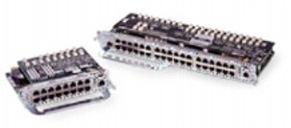
SINGLE PLATFORM SOLUTION FOR BRANCH OFFICE IP TELEPHONY AND VOICE GATEWAY
As the migration to converged voice/data networks accelerates, enterprises need to deploy a platform that has the ability to immediately or gradually grow to support a wide range of traditional telephony devices in addition to newer IP telephony solutions. The Cisco 3700 Series delivers on that need by supporting legacy phone systems through a variety of scalable analog telephony connectivity options starting at two analog ports and scaling to 16, 32, 48 or 64 analog ports. Digital telephony connectivity is just as scalable with options beginning at 12 channels and scaling up to up to 480 channels. IP telephony solutions are also supported on the Cisco 3700 Series through a powerful set of features including line powered IP phone connectivity that begins with 16 ports and scales to 36, 52, or 72 ports in a single platform.
The performance-tuning of the Cisco 3700 Series enables customers to apply quality of service, bandwidth optimization and fragmentation services, along with other advanced call admission control, call control and queuing mechanisms, without sacrificing the expected data performance needed for future growth. The Cisco 3700 Series offers resilient IP telephony services, including Survivable Remote Site Telephony (SRST), H.323, SIP and MGCP, and redundant power for the system and IP phones.
With the Cisco 3700 Series, enterprises can deploy this scalable platform to support all of their telephony needs without investing in all connectivity requirements in the initial deployment. The enhanced service density of the Cisco 3700 allows enterprises the opportunity to deploy a base level configuration that will scale to the converged telephony needs of that branch when necessary. This modular telephony format mitigates future technology lockout.
Deployment of IP Telephony infrastructure solutions are facilitated by the following key Cisco 3700 features:
The evolution from traditional TDM voice to IP Telephony has created the requirement that branch offices be equipped to deploy IP Telephony solutions without the need to replace the branch office access platforms. The Cisco 3700 series fulfills that need by ensuring complete support for the range of voice gateway densities and IP Telephony features necessary for Enterprises' evolving branch office infrastructures.
Figure 5
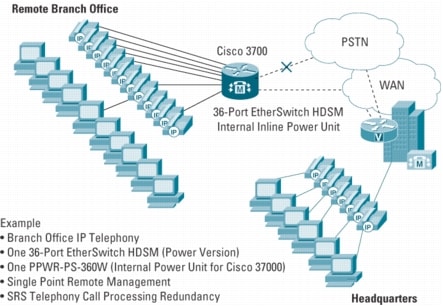
3700 Full Service Branch Integrated Capabilities
Figure 6
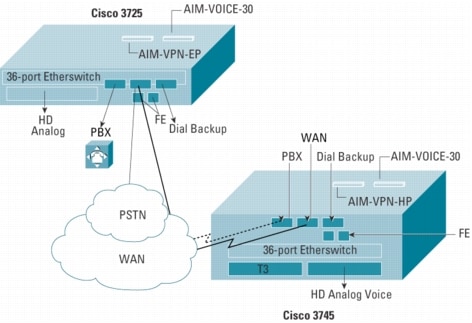
Full Service Branch Scenarios
Cisco 3700 enables higher service densities through a versatile, wider interface form factor (using a HDSM), additional interface options with three WIC slots, CPU offload with two built-in AIM slots, and on-board LAN/WAN connectivity to free up module slots.
Table 2. Supported Interfaces for the Cisco 3700 Series
|
Interfaces |
Description |
|
LAN/WAN |
|
|
LAN |
|
|
Serial |
|
|
ISDN/Channel |
|
|
Voice |
|
|
ATM |
|
|
Modem |
|
|
Services |
|
|
Security, VPN and Compression |
|
|
Content Delivery |
|
|
Network Analysis |
|
|
Processor Type |
|
|
Performance |
|
|
Flash Memory (Compact Flash) |
|
|
System Memory |
|
|
Integrated WIC Slots |
|
|
Onboard AIM (internal) |
|
|
Console Port |
|
|
Aux Port |
|
|
Minimum Cisco IOS Release |
|
|
Onboard LAN Ports |
|
|
Redundant Power Supply Support |
|
|
Rack Mounting |
|
|
Power Requirements |
|
|
Power Supply |
|
|
Heat Dissipation |
|
|
Output |
|
|
AC Input Voltage |
|
|
Frequency |
|
|
AC Input Current |
|
|
Environmental Specifications |
|
|
Operating Temperature |
|
|
Nonoperating Temperature |
|
|
Relative Humidity |
|
|
Operation Altitude |
|
|
Dimensions (HxWxD) |
|
|
Weight (without NMs or WICs or additional Power Supplies) |
|
|
Network Modules |
NM-16ESW, NM-16ESW-PWR, NM-16ESW-1GIG, NM-16ESW-PWR-1GIG, NMD-36-ESW, NMD-36-ESW-PWR, NMD-36-ESW-2GIG, NMD-36-ESW-2G, NM-1FE-FX-V2, NM-1FE-SMF, NM-1FE2W, NM-2FE2W, NM-1FE1R2W, NM-1FE2W-V2, NM-2FE2W-V2, NM-2W, NM-1HSSI, NM-4A/S, NM-4B-S/T, NM-4B-U, NM-8A/S, NM-8B-S/T, NM-8B-U, NM-16A/S, NM-1CT1, NM-1CT1-CSU, NM-2CT1, NM-2CT1-CSU, NM-1CE1B, NM-1CE1U, NM-2CE1U, NM-2CE1B, NM-1CE1T1-PRI, NM-2CE1T1-PRI, NM-4E1-IMA, NM-4T1-IMA, NM-8E1-IMA, NM-8T1-IMA, NM-1A-T3, NM-1A-E3, NM-1V, NM-2V, NM-HDA-4FXS, NM-HDV-1T1-12, NM-HDV-1E1-12, NM-HDV-1E1-30, NM-HDV-1E1-30E, NM-HDV-2E1-60, NM-HDV-1T1-24, NM-HDV-2T1-48, NM-HDV-1T1-24E, NM-HDV-2T1-48, NM-6DM, NM-12DM, NM-18DM, NM-24DM, NM-30DM, NM-16A, NM-32A, NM-1A-OC3MM, NM-1A-OC3SMI, NM-1A-OC3SML, NM-1A-OC3MM-EP, NM-1A-OC3SMI-EP, NM-1A-OC3SML-EP, NM-1GE, NM-1T3/E3, NM-CE-BP-SCSI-K9, NM-CE-BP-20G-K9,NM-CE-BP-40G-K9, NM-4T, NM-8AM, NM-16AM, NM-8AM-V2, NM-16AM-V2, NM-CUE, NM-HD-1V, NM-HD-2V, NM-HD-2VE, NM-HDV2, NM-HDV2-1T1/E1, NM-HDV2-2T1/E1, NM-CEM-4TE1, NM-CEM-4SER, NM-NAM |
|
WICs, VWICs, and VICs |
WIC-1T, WIC-2T, WIC-2A/S, WIC-1B-S/T, WIC-1B-S/T-V3, WIC-1B-U, WIC-1B-U-V2, WIC-1DSU-56K4, WIC-1DSU-T1, WIC-1DSU-T1-V2, VWIC-1MFT-T1, VWIC-2MFT-T1, VWIC-2MFT-T1-DI, VWIC-1MFT-E1, VWIC-2MFT-E1, VWIC-2MFT-E1-DI, VWIC-1MFT-G703, VWIC-2MFT-G703, WIC-1ADSL, WIC-1ADSL-DG, WIC-1ADS-I-DG, WIC-1SHDSL, WIC-1SHDSL-V2, WIC-1AM, WIC-2AM, VIC-2DID, VIC-2FXS, VIC-2FXO, VIC-2FXO-EU, VIC-2FXO-M1, VIC-2FXO-M2, VIC-2FXO-M3, VIC-2E/M, VIC-2CAMA, VIC-2BRI-S/T-TE, VIC-2BRI-NT/TE, VIC-4FXS/DID, VIC2-2FXS, VIC2-2FXO, VIC2-4FXO, VIC2-2E/M, VIC2-2BRI-NT/TE |
|
AIMs |
AIM-VPN-HP, AIM-VPN-EP, AIM-VPN/EPII, AIM-VPN/HPII, AIM-VPN/EPII-PLUS, AIM-VPN/HPII-PLUS, AIM-ATM, AIM-VOICE-30, AIM-ATM-VOICE-30, AIM-COMPR4, AIM-CUE |
ORDERING INFORMATION
The Cisco 3700 Series is orderable through the following part numbers:
|
Part Number |
Description |
|
CISCO3725 |
3700 Series, 2-Slot, Dual FE, Multiservice Access Router |
|
CISCO3745 |
3700 Series, 4-Slot, Dual FE, Multiservice Access Router |

